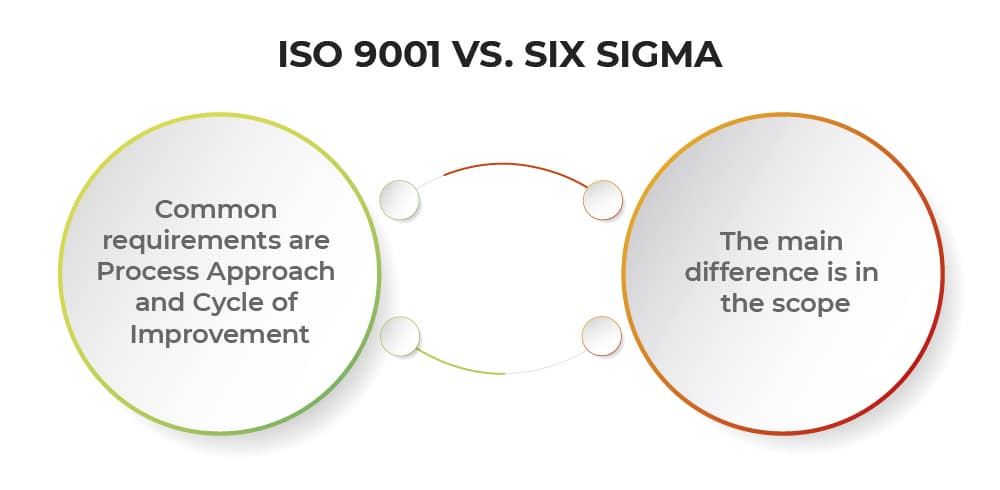Have you considered adding Six Sigma methodologies as a way of focusing the improvement activities in your quality management system? If so, yours is one of several companies that see the benefits of process improvement as a way of saving time and money. Although continual improvement is a key principle of the ISO 9001 standard, the standard does not explain how to implement or maintain this improvement. The Six Sigma method provides this how-to information. Six Sigma is a collection of process improvement techniques and tools which can be used to improve the processes, and can be applied to processes within the quality management system that is defined by the ISO 9001 standard.
- Common requirements are Process Approach and Cycle of Improvement
- The main difference is in the scope
Similarities
There are several requirements that are common to the ISO 9001 standard and the Six Sigma methodologies; as such, these can be done together to meet the requirements of both within the processes defined in the QMS:
Process Approach. Both ISO 9001 and Six Sigma use a process approach in applying their methodologies. ISO 9001 involves looking at an overall system as smaller, interrelated processes to focus efforts toward more consistent and predictable results on the individual processes of the system. This is done because controlling and improving the individual processes can be a much easier and more effective way to control and improve the entire system. Six Sigma is used on an individual process in order to control and improve it using a SIPOC diagram (an abbreviation for Supplier, Inputs, Process, Output, and Customers). SIPOC is a way of representing the process in order to better understand how it works, and how improvements are effective on the process.
Cycle of Improvement. Both systems have an underlying methodology of using a cycle for improvement. ISO 9001 is based on a Plan-Do-Check-Act cycle that is used to focus efforts on improvement in the system. This allows for an ongoing cycle where changes are made to improve an aspect of the system, then checked and acted upon to either correct for problems or cement improvements that are realized. I have explained this further in another post on Plan-Do-Check-Act in the ISO 9001 Standard. The core tool used in Six Sigma for process improvement projects is the DMAIC project methodology (an abbreviation for Define, Measure, Analyze, Improve and Control), which is an improvement cycle based on data that is used to improve, optimize and stabilize business processes. With both systems, all phases of the cycle must be followed for the cycle to work; skipping steps can cause failure.
With these common elements it would seem logical that Six Sigma can be used as one of the main methodologies for attaining process improvement within the ISO 9001 quality management system.
Differences between Six Sigma and ISO 9001
The main difference between ISO 9001 and Six Sigma is in the scope. The ISO 9001 standard is an internationally recognized set of requirements to use as the basis to develop an entire quality management system, including all aspects of the business such as management responsibilities, resource management and all aspects of providing the product or service. Additionally, the implemented QMS can be certified against the ISO 9001 requirements (See How to get ISO 9001 certified). Meanwhile, Six Sigma is solely a set of tools and methods used to improve business processes, and which are not meant as a means of developing an entire quality management system. In addition, there is no standardized set of requirements that are recognized worldwide, as this is primarily implemented in North America. This limited scope can make the Six Sigma methodologies very useful as the tool used within the quality management system, designed to the ISO 9001 requirements, for process improvement.
Additionally, Six Sigma has a subset project methodology used for design, which is referred to as Design for Six Sigma (DFSS). This project replaces the DMAIC cycle used above and replaces it with a cycle more focused on the design, which is the DMADV project methodology. These five stages stand for Define design goals, Measure and identify critical characteristics, Analyze to develop and design alternatives, Design an improved alternative, and then Verify the design. This methodology is not equivalent to the design process defined in ISO 9001 (see The ISO 9001 Design Process Explained), but could be used as a method of design improvement, which would then feed into the design change requirements of the ISO 9001 quality management system.
Some elements of Six Sigma will require new processes not already implemented in a quality management system, but the addition of the processes should complement the process improvement requirements of the system already in place. There are no fundamental conflicts between the requirements, only additions to what would already be present.
Using system synergies to save time and money
It is not an either/or choice between ISO 9001 and Six Sigma; both can be used. ISO 9001 will provide the QMS framework, and Six Sigma can help provide the process improvements required by the quality management system. Integrating Six Sigma into your ISO 9001 quality management system can help to focus the resources used for improvement by using a set of tried and trusted tools and techniques, saving both time and money for a company. Improvement for cost and time savings is one of the main reasons for implementing a quality management system in the first place, and having a set of tools to guide you in this endeavor can mean the difference between success and failure.
To implement ISO 9001 easily and efficiently, use our ISO 9001 Premium Documentation Toolkit that provides step-by-step guidance and all documents for full ISO 9001 compliance.

 Mark Hammar
Mark Hammar 




